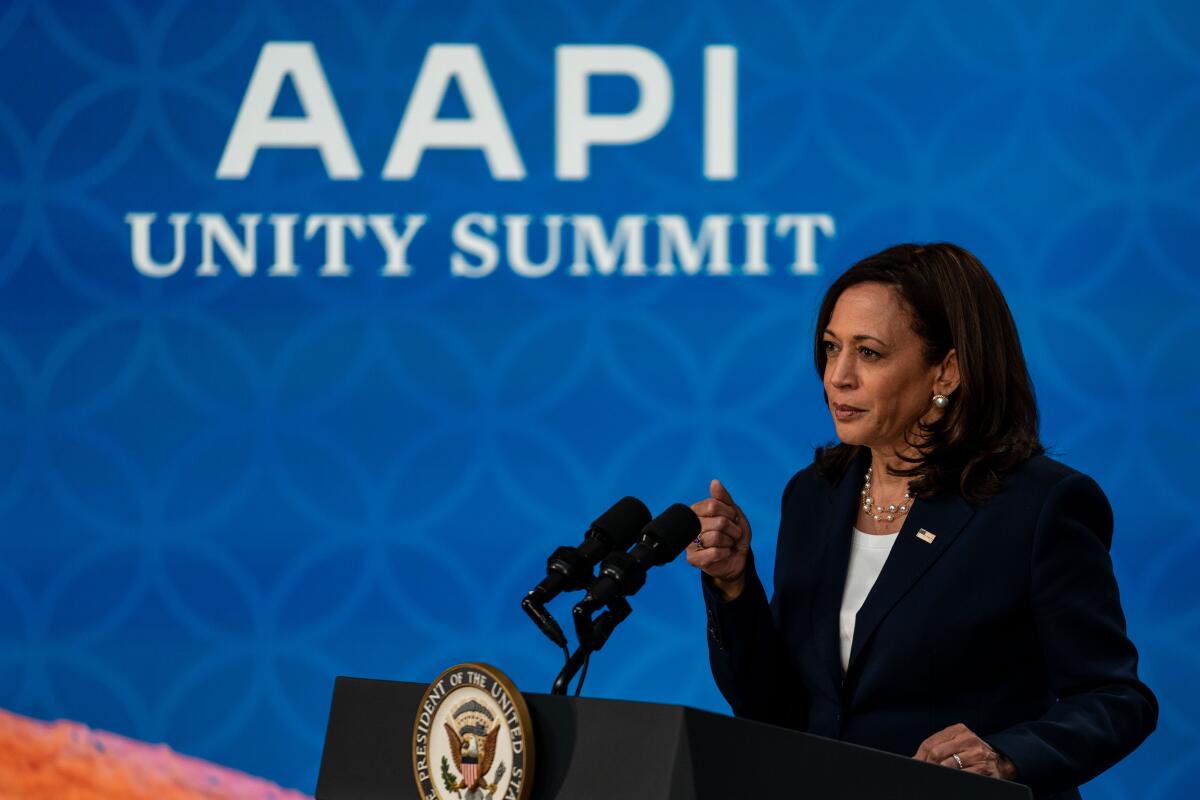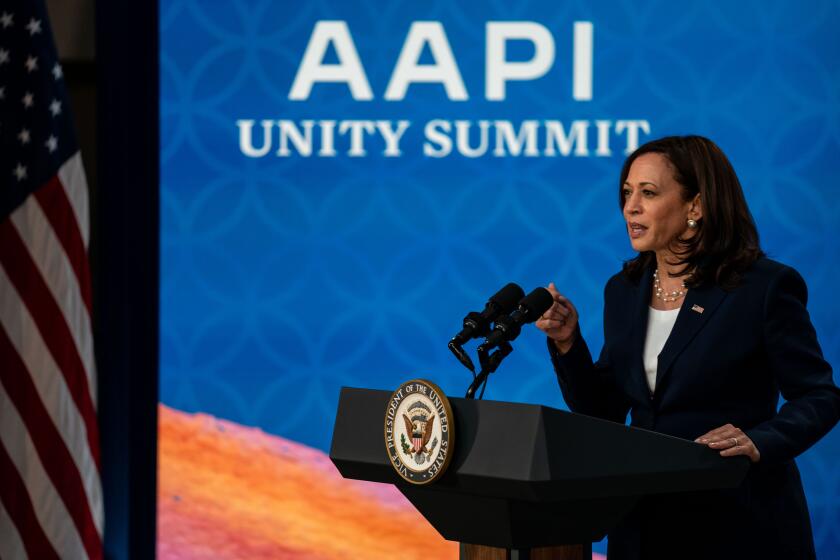Opinion: Are Asian American voters loyal to Democrats or shifting Republican?

- Share via
There are more than 700 Asian American elected officials across the country, including the presumed Democratic Party presidential nominee Kamala Harris and 20 members of Congress. Since the data show a leftward bent among Asian Americans Gen X and younger, one might expect that representation to be entirely Democratic. But Asian Americans have long had an energetic presence in the Republican Party. It’s worth asking how attractive the GOP might look to them come November.
George H.W. Bush won this voting bloc 32 years ago. So did Bob Dole in 1996. In recent years, Elaine Chao, Nikki Haley, Vivek Ramaswamy and now Usha Vance have become household names. Although Haley and Ramaswamy failed to win the GOP presidential nomination against Donald Trump, they snagged speaking slots at the 2024 Republican National Convention to show their commitment to conservatism (however defined these days). They, along with California U.S. Reps. Vince Fong, Young Kim and Michelle Steel and Asian American politicians elsewhere, underscore the growing visibility of this demographic within elite GOP circles.
The long history of Asian American activism from the right started with Hiram Fong, who was born to Chinese immigrants in Hawaii. He became a U.S. senator from the newly admitted state in 1959 and during his 18-year tenure built a reputation as a moderate. Fong secured funds to improve the islands’ infrastructure, helped remove immigration barriers and backed sweeping civil rights legislation. He was also an ardent supporter of the Vietnam War and President Nixon, even after the fallout from Watergate.
Asian American groups that helped Democrats win the White House and Congress say moments of triumph and tribulation for their community are intertwined.
The year Fong left office, S.I. Hayakawa, a Canadian-born Japanese American, began his term as U.S. senator from California as a somewhat inscrutable Republican. A self-proclaimed supporter of racial minorities, he nonetheless opposed the establishment of ethnic studies in 1969 as president of San Francisco State College (now University), a position he was appointed to by then-Gov. Ronald Reagan. Hayakawa did not hide his Japanese heritage, yet he also promoted assimilation and wanted to make English the official language of America. In the late 1960s and 1970s, Hayakawa’s brand of identity politics was palatable for a Republican Party becoming increasingly conservative thanks to the “Southern strategy” (a GOP tactic that used race to attract aggrieved Sunbelt white voters) and a burgeoning evangelical movement.
There were also Asian American bureaucrats, diplomats and lobbyists influencing the right from behind the curtain. These efforts included Anna Chan Chennault, a journalist-turned-socialite whose political and military ties through her husband, U.S. Maj. Gen. Claire Chennault, provided access to Republicans such as Richard Nixon. In 1968, amid the race for the White House, Anna Chennault served as an intermediary between Nixon and South Vietnam. Though the lore remains disputed, experts have claimed she helped stall peace negotiations between embattled Democratic incumbent President Lyndon B. Johnson and South Vietnamese leaders, as she and fellow Nixon supporters feared a deal would help Democrat Hubert Humphrey clinch the election. Nixon won. Well after the “Chennault affair,” she remained a reliable GOP ally, fundraising for the party and mentoring Asian American Republicans.
In the 1980s and 1990s, the Republican Party made significant inroads with Asian American voters thanks to the efforts of former Nixon, Reagan and Bush administration officials invested in improving U.S.-Asia relations, particularly with China. Moreover, outreach to specific demographic groups as promoted by Republican National Committee Chairman Lee Atwater — who, paradoxically, also encouraged the use of dog whistles on the campaign trail — brought Asian Americans into the tent.
How new arrivals remade the east San Gabriel Valley — and assimilated in it.
But by the mid-2000s, despite the prominence of figures including Matt Fong, Bobby Jindal, Jay Kim and Pat Saiki, Asian Americans’ support of the GOP and their overall presence within the larger party apparatus declined. Targeted appeals from Democratic Party operatives put Asian Americans solidly in the blue column. Democrats’ positions on education and healthcare, and the party’s overall image as more racially and religiously inclusive, attracted recent immigrants and younger voters. By the time George W. Bush finished his first term, it appeared the GOP had all but abandoned the Asian American electorate.
Then there was another turn. In 2013, following Mitt Romney’s failed presidential bid and tepid election results for the party, the Republican National Committee came out with the Growth and Opportunity Project (a.k.a. the “RNC autopsy”) that suggested a renewed focus on people of color. The RNC hired dedicated staff to assist with Asian American outreach for the next election cycles — albeit inconsistently — to boost turnout in swing districts and states where these votes were crucial. This includes Georgia, Nevada, Ohio, Pennsylvania, Texas and Virginia, among others. State and local parties have also tried direct outreach and placing Asian American Republicans in leadership roles.
Some of these efforts seem to have worked. Since 2020, despite the Trump administration’s rhetoric labeling COVID-19 the “China virus” and a subsequent uptick of anti-Asian violence, there’s an emerging conservative element within Asian America.
Not all are registered Republicans, and these conservative activists are more common in areas with larger Asian American and Pacific Islander populations. Many have gotten involved in local politics, such as ousting progressive district attorneys and recalling liberal school board members. The Democratic Party’s increasingly progressive priorities have scanned to some Asian Americans, particularly immigrants and refugees, as reminiscent of socialism or communism, ideologies often associated with violent regimes and restricted freedoms in the homeland. Furthermore, some Asian Americans argue that diversity, equity and inclusion initiatives overlook Asian Americans or teach anti-American-ness; some oppose affirmative action and similar programs or think authorities have not strongly enough countered anti-Asian violence, pushing them rightward.
Indeed, in the 2020 and 2022 elections, Democrats won Asian Americans’ votes in national elections by noticeably smaller margins than in years past. November will give us some sense of whether this trend will keep moving in the GOP’s favor — or swing back toward stalwart Democratic support.
James Zarsadiaz is an associate professor of history at the University of San Francisco and the author of “Resisting Change in Suburbia.” He is working on a book about Asian American conservatism since the Cold War.
More to Read
A cure for the common opinion
Get thought-provoking perspectives with our weekly newsletter.
You may occasionally receive promotional content from the Los Angeles Times.












